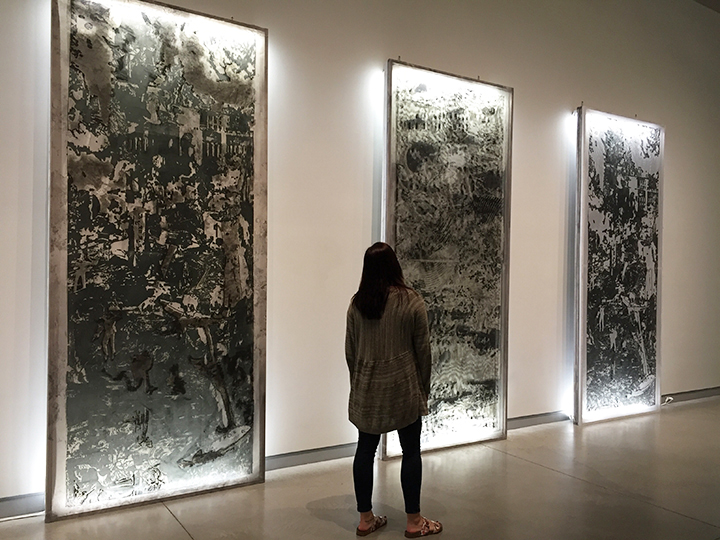New York-based artist Rob Swainston’s solo exhibition—We thought they thought what we thought, but they didn’t.—is on view at University Galleries of Illinois State University through September 11. All exhibitions and events are free and open to the public.
Swainston’s recent woodblock prints are dark and overpowering. Printed on oversized sheets of fabric or paper, their saturated, off-register layers of barely decipherable imagery penetrate the viewer’s consciousness like newsprint rubbing off on a reader’s fingers. Their overall effect speaks to our experience of a time in which fact easily passes as fiction, subterfuge is systemic, and the endless stream of simultaneous information we absorb never quite falls into line.
This is all the more interesting given the woodblock’s history as the earliest print form, from its decorative origins in second-century China to its pinnacle in mid-15th century Europe and its revival by the German Expressionists. Throughout Swainston’s two-room installation, this time-honored technology appears in uncommon, multi-layered formats: framed backlit three-tiered images on semitransparent fabric rising from the floor like monoliths, a 16-foot-high print recalling Chinese scrolls, multicolored variations on a single image struck over digital prints, 55 woodcuts shingled together floor-to-ceiling in the shape of pyramid, and a ceiling-mounted reproduction of a woodcut enhanced by a video projection.
Swainston provokes the viewer to consider the commonalities and problematics of image-making technologies over the centuries—how moiré effects resulting from fabric placed against fabric predate holography, how the low resolution of early photography resembles that of prior hand-printed techniques, and how regardless of what we are looking at, the mind takes its best shot at filling in missing visual information. As beautiful as it is unsettling, Swainston’s work is evocative of some of the finest moments in art history: Han Dynasty printing on silk, early Renaissance military scenes, Hokusai’s waves, Clyfford Still’s dark-hued paintings, and, perhaps most markedly, Warhol’s exploitation of accidental image slippage in series such as the Disaster paintings. Swainston deftly weaves between the bucolic and the topical, offering a view that is lush but at the same time eerily reminiscent of night-vision optics.
Born and raised in rural Pennsylvania, Swainston received a B.A. in art and political science at Hampshire College, in Amherst, Massachusetts, and an M.F.A. in visual arts from Columbia University. He is an alumnus of the Philadelphia art collective Vox Populi, and founder and master printer at Prints of Darkness, a collaborative print shop in Brooklyn. He has had solo exhibitions at Marginal Utility, Philadelphia; Neuwerk Kunsthalle, Konstanz, Germany; David Krut Projects, New York; and BravinLee Programs, New York. Group exhibitions and public projects include The Bronx Museum of the Arts; NYC Parks; Socrates Sculpture Park, Queens; The Queens Museum; Arlington Arts Center, Arlington, Virginia; Provincetown Art Association and Museum; and Frederic Snitzer Gallery, Miami. His work has been featured in Art in Print, V-magazine, Printeresting, and Art21 blogs. Swainston is assistant professor of art and design in printmaking at SUNY Purchase. He lives and works in Brooklyn and Queens, respectively.
This exhibition was curated by Barry Blinderman, director of University Galleries.

